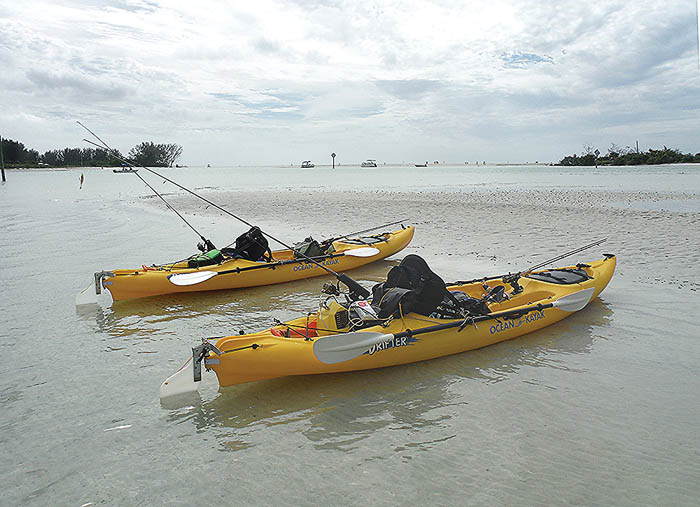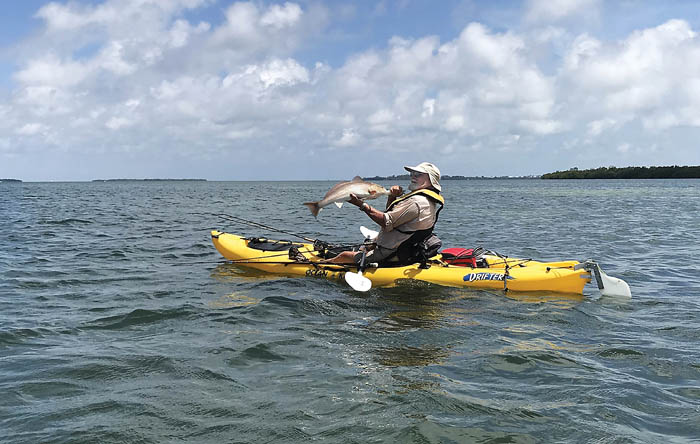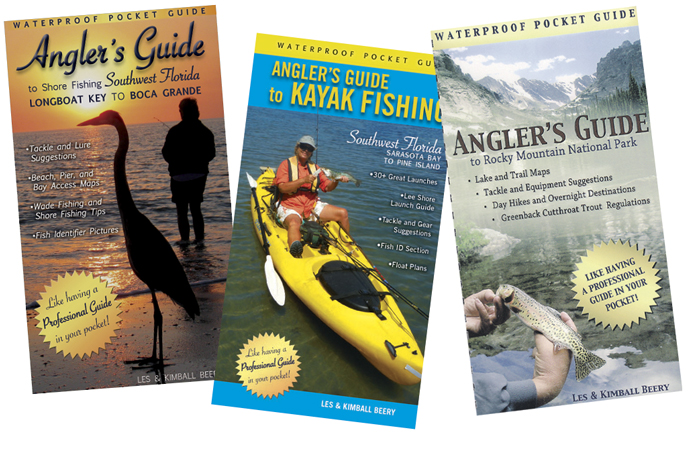Shore & Kayak Fishing
October 25, 2023 at 12:26 p.m.
Rods, Reels, Lines and Leaders

The first trip to a tackle shop can overwhelm a beginning kayak angler with the selection of tackle available. Every tackle choice has its following of anglers. We would not presume to tell anyone that our choice of tackle is the best for everyone but here are some things we consider when confronted with a confusing array.
Let’s start with rods. Many boat anglers and folks with pickup trucks around here prefer one-piece rods. These are an excellent choice but are awkward to haul in an SUV or on a kayak. Most folks have seen a kayak with an array of rods vertically mounted in rod holders behind the seat. While access is okay, they can be in the way for the folks stalking reds and snook close to the mangroves or when a jack crevalle circles the kayak. While visions of battling a big snook to a boat are realistic, these snook will usually drag a kayak into the mangroves. This leaves you with one hand on your rod, one fending off the branches and trying to control your paddle, and none to reposition those rods that are now entangled in branches above your head. You could use a stake out pole to hold the kayak off the mangroves after a strike, but we’re usually too busy at that point. Carrying one-piece rods vertically in a rod holder also adds to wind resistance and doesn’t play nice with low bridges or overhanging branches on our inland creeks. Graphite rods are known to attract lightning which no kayak angler really needs while seeking shelter from a storm.
Two- or four-piece rods are our favorite. We can “field break” them when not in use to half their extended length so in a rod holder they are barely taller than a seated paddler and won’t hang up as easily. The key factor we look for in a quality rod is for the tip to be protected by the butt end when “broken down” to half length. The rods we avoid leave the tip sticking out past the butt in harm’s way when collapsed.

Kayak anglers have different ideas about rod length too. Some prefer short rods while others prefer longer rods to compensate for the paddler’s low position when seated at water level. For general inshore fishing in salt water, we like 7 ft., medium power, fast action graphite spinning rods. When hunting bass on small freshwater creeks, a 6 ft. rod is easier to work with. When fly fishing, we use 9-foot, 8-weight, 4-piece rods with WF floating line for both bass and inshore saltwater targets.
All reels suffer on a saltwater kayak trip. Manufacturers have developed waterproof designs priced north of $500 to help reels live longer. These are designed to be a onetime investment and require the least maintenance. At the other end, big box stores have reels for less than $20 that we consider temporary and expendable though, in freshwater, they can last for years. Towards the middle, you’ll find reels that will last for years with a little TLC. Look for sealed drags and metal gears in the 2,000 – 3,000 size. These hold plenty of 10 – 20 lb. braided line for an encounter with a bigger fish than you expected. Setting your reel’s drag for about ½ of the line/leader strength will tire most fish quickly. Try not to dunk your reel in saltwater. Be sure to rinse off rods and reels in freshwater at the end of the day, even if you don’t accidentally dunk them. The wet line on the spool holds enough saltwater to cause trouble.
Anglers new to inshore saltwater purchase heavier tackle than experienced anglers use. They leave a tackle store with stout lines, steel leaders, too much lead and hooks big enough for a shark. There are few fish in our local waters that can’t be managed with 20 lb. braid and 40 lb. fluorocarbon leader. We normally use 10 lb. braid with 20 lb. fluorocarbon leader and still control the larger fish we target. Lighter line casts farther. Light leader is harder for fish to see and won’t affect the action of the lure or bait.
We hope these ideas help new kayak anglers enjoy the excellent fishing we have here in southwest Florida. Now, get out there and have some fun. If these ideas help you catch more fish, please limit your kill; don’t kill your limit. After a successful release, your fish can thrill another angler, reproduce for years, and grow bigger if you catch it again.

Kimball and Les Beery, authors of Angler’s Guide to Shore and KAYAK Fishing Southwest Florida, contribute these excerpts from both Waterproof books to promote the excellent fishing available in the Englewood area. They are available locally at Old Florida Gallery on West Dearborn, and for download at www.anglerpocketguides.com & amazon.com.